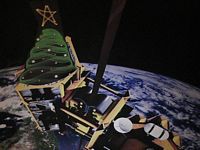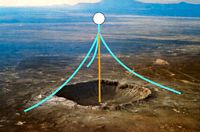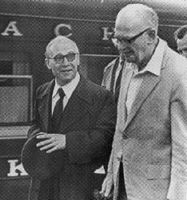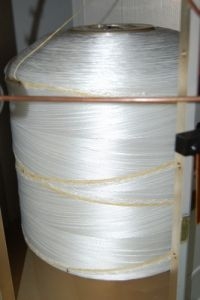This morning, I received the following email from Ben Shelef at the Spaceward Foundation, wrapping up 2007 – a great year for the Space Elevator community. If you want to get on the Spaceward Foundation’s email list, just visit them at their Homepage and sign up.
Spaceward Foundation News Bulletin
Newsletter #4 – December 31, 2007
Hello folks, and Happy New Year!It’s been a while since our last newsletter – seems that whenever something’s going on in Space Elevator land, we’re always too busy to write. 🙂 Two months after the 2007 games, this is a good time to briefly reflect on this past year, and update you on our next steps for ’08 and beyond.In this newsletter:
- A look back at 2007
- A preview of our plans for 2008
- A new partner
- Carbon Nanotube news
2007:For those who missed the real-time action, the official wrap-up of the 2007 Spaceward Games is posted online at www.spaceward.org/games07Wrapup.html. As usual, you can re-live the day-by-day coverage at the archives at Ted Semon’s Space Elevator Blog and Marc Boucher’s Space Elevator Reference.The most significant result of the 2007 games, however, is not measured in units such as kilograms or in meters per second. What we saw in 2007 was a huge leap in the level of technology fielded by the teams. In particular, our two laser-based teams, USST and LaserMotive, designed and built complex advanced systems worthy of an aerospace project, and have acquired a set of capabilities that attracted industry interest to our competition. In terms of fulfilling the charter of the games, we could not have asked for more.Looking back, you may remember that Space Elevator games did not exist before 2005. Unlike our role models – Solar car races and rocketry clubs, we did not have a rich tradition of games spanning tens of years to rely on. We started practically from scratch, and we are immensely proud of how our teams have grown.
Having wrapped up the games, our next order of business was charting the course for 2008. The immediate choices we looked at were keeping the challenge goals the same as in ’07, doubling the speed or height requirements, or doubling both. However, after gathering feedback from existing and potential teams, the Space Elevator community, and relevant industry experts, we decided to go for something a bit more grandiose…
2008:In broad strokes, the goal of the Space Elevator games is to bring the Space Elevator closer to reality. The goal of the power beaming challenge is to promote power beaming technology. We think that the time is ripe now to move the competition to the next level, addressing real-world power beaming scenarios where the minimum requirements for such systems start at the km range and kWatt power levels.For the 2008 power beaming challenge, therefore, we’ve chosen a climb height of 1 km.There’s a drum roll missing here. 1 km is the height a jetliner is at when the cabin crew asks you to put your laptop away… To show what a 1 km tall race track looks like, we’ve posted a preview at the Power Beaming page. (The location shown is hypothetical, of course!) Also note the comparison to the 2007 games – those were held inside the small orange circle just below and to the left of the center-image.
To match the change in scope, we’re also increasing the available prize money. As a matter of fact, we will be making the entire $2,000,000 available this year, depending on the speed of the climb. For 2 m/s, we’ll be offering the originally scheduled $900k prize, but if a team can reach 5 m/s this year, it will receive the entire $2M purse. If not claimed, we’ll keep the prizes and challenge the same for 2009.
The racetrack we’re planning, based on a pyramid-tethered balloon, will be the tallest such pyramid ever flown. We’re working with industry experts to set this up, and will keep you updated. This is very exciting for us, since this architecture is extendable to 10 km as well – almost a percent of a percent of the real Space Elevator…. In all seriousness though, while obviously all Earth-bound Space Elevator models are vastly shorter than the real thing, as far as reproducing the look-and-feel of a Space Elevator, this setup will go a long way towards demonstrating what the SE will be like.
Registration for the 2008 games is now open, and the first teams have already started working on their entries.
TRUMPF, Inc.We are very excited to announce the participation of TRUMPF as a sponsor for competition teams. TRUMPF will provide their top-of-the-line laser to qualifying teams to be used as the beam source, easily enabling 1 km power beaming.
CNTs:Finally, last but definitely not least, we’d like to share this exciting bit of news about Carbon Nanotube tethers: About a month ago, as reported at the Space Elevator conference in Luxembourg, a team from Cambridge University produced the first macroscopic carbon fibers that exhibited the kind of strength we were all expecting so see. These fibers, up to 1 mm long, clocked in at 10 N/tex, or about a fifth of what we need to build the Space Elevator (see here for details) We’re looking forward to seeing this team and other CNT labs entering the tether competition next year.
So with this happy bit of news we’ll sign off for this newsletter.
Have a happy new year!
The Spaceward Team.
The Spaceward Foundation is a 501(c)(3) educational non-profit dedicated to furthering Space exploration in educational curriculums and the public mindshare – http://www.spaceward.org.





 In my
In my 



 Yesterday, Dr. David Livingston of The Space Show interviewed Dr. Bradley Edwards and Ms. Carla Sabotta.
Yesterday, Dr. David Livingston of The Space Show interviewed Dr. Bradley Edwards and Ms. Carla Sabotta. In April of this year, I posted about a couple of tether launches scheduled for later in the year. One was from Tethers Unlimited, home of the esteemed Robert Hoyt (documented
In April of this year, I posted about a couple of tether launches scheduled for later in the year. One was from Tethers Unlimited, home of the esteemed Robert Hoyt (documented  Since the competition, LaserMotive has put up a number of posts on their blog. These cover everything from who some of their sponsors / suppliers were, to qualifying videos to problems with their brakes, etc. Rather than trying to summarize each one, just go visit their blog,
Since the competition, LaserMotive has put up a number of posts on their blog. These cover everything from who some of their sponsors / suppliers were, to qualifying videos to problems with their brakes, etc. Rather than trying to summarize each one, just go visit their blog,